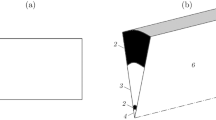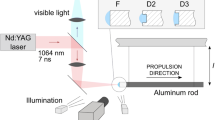Abstract
In this article, an optical method to control the break-up of high-speed liquid jets is proposed. The method consists of focusing the light of a pulsed laser source into the jet behaving as a waveguide. Experiments were performed with the help of a Q-switched frequency doubled Nd:Yag laser (λ=532 nm). The jet diameter was 48 µm and jet velocities from 100 to 200 m/s. To study the laser-induced water jet break-up, observations of the jet coupled with the high power laser were performed for variable coupling and jet velocity conditions. Experimentally determined wavelength and growth rate of the laser-generated disturbance were also compared with the ones predicted by linear stability theory of free jets.













Similar content being viewed by others
References
Collicott SH, Zhang S, Schneider SP (1994) Quantitative liquid jet instability measurement system using asymmetric magnification and digital image processing. Exp Fluids 16:345–348
Ding X, Kawagushi Y, Niino H, Yabe A (2002) Laser-induced high-quality etching of fused silica using a novel aqueous medium. Appl Phys A 75:641–645
Dolgaev SI, Lyalin AA, Simakin AV, Shafeev GA (1996) Fast etching of sapphire by a visible range quasi-cw laser radiation. Appl Surf Sci 96:491–495
Donnelly RJ, Glaberson W (1966) Experiments on the capillary instability of a liquid jet. Proc R Soc Lond Ser A, Math Phys Sci 290:547–556
Goedde EF, Yuen MC (1970) Experiments on liquid jet instability. J Fluid Mech 40:495–511
Grant RP, Middleman S (1966) Newtonian jet stability. AIChE J 12:669–678
Kuzuu N, Yoshida K, Yoshida H, Kamimura T, Kamisugi N (1999) Laser induced bulk damage in various types of vitreous silica at 1064, 532, 355 and 266 nm: evidence of different damage mechanisms between 266 nm and longer wavelengths. Appl Opt 38:2510–2515
Lafrance P (1975) Nonlinear breakup of a laminar liquid jet. Phys Fluids 18:428–432
Leroux S, Dumouchel C, Ledoux M (1996) The stability curve of Newtonian liquid jets. Atom Sprays 6:623–647
Lin S, Reitz RD (1998) Drop and spray formation from a liquid jet. Annu Rev Fluid Mech 30:85–105
Noack J, Hammer DX, Noojin GD, Rockwell BA, Vogel A (1998) Influence of pulse duration on mechanical effects after laser-induced breakdown in water. J Appl Phys 83(12):7488–7495
Preziosi L, Chen K, Joseph DD (1989) Lubricated pipelining: stability of core-annular flow. J Fluid Mech 201:323–356
Rayleigh, Lord (1878) On the instability of jets. Proc Lond Math Soc 10:4–13
Rayleigh, Lord (1879) On the capillary phenomena of jets. Proc R Soc 29:71–97
Richerzhagen B (2001) Chip singulation process with a water-jet guided laser. Solid State Technol 44(4):25–28
Rutland DF, Jameson GJ (1971) A non-linear effect in the capillary instabillity of liquid jets. J Fluid Mech 46:267–271
Spiegel Á, Vágó N, Wagner FR (2004) High efficiency Raman scattering in micro water jets. Opt Eng 43(2):450–454
Sterling AM, Sleicher CA (1975) The instability of capillary jets. J Fluid Mech 68(3):477–495
Taub HH (1976) Investigation of nonlinear waves on liquid jets. Phys Fluids 19:1124–1129
Vágó N, Spiegel Á, Couty P, Wagner FR, Richerzhagen B (2003) New technique for high-speed microjet breakup analysis. Exp Fluids 35:303–309
Vogel A, Lauterborn W, Timm R (1989) Optical and acoustic investigations of the dynamics of laser-produced bubbles near a solid boundary. J Fluid Mech 206:299–338
Wood RM (1986) Laser damage in optical materials. Adam Hilger Press, Bristol
Wood RM (1995) Pulse duration dependance of laser damage mechanisms revisited. SPIE 2428:531–545
Xing JH, Boguslawski A, Soucemarianadin A, Atten P, Attanë P (1996) Experimental investigation of capillary instability: results on jet stimulated by pressure modulations. Exp Fluids 20:302–313
Acknowledgements
The authors are grateful to the Commission for Technology and Innovation (KTI/CTI project N5314.3 KTS) for co-financing this work. The experiments have been carried out and supported by the Research and Development laboratory of the company SYNOVA SA where the Laser-Microjet® technology is developed and applied. The authors are very grateful for the collaboration of the director Bernold Richerzhagen and the head of the R&D group Frank Wagner.
Author information
Authors and Affiliations
Corresponding author
Rights and permissions
About this article
Cite this article
Couty, P., Spiegel, Á., Vágó, N. et al. Laser-induced break-up of water jet waveguide. Exp Fluids 36, 919–927 (2004). https://doi.org/10.1007/s00348-003-0775-x
Received:
Accepted:
Published:
Issue Date:
DOI: https://doi.org/10.1007/s00348-003-0775-x




